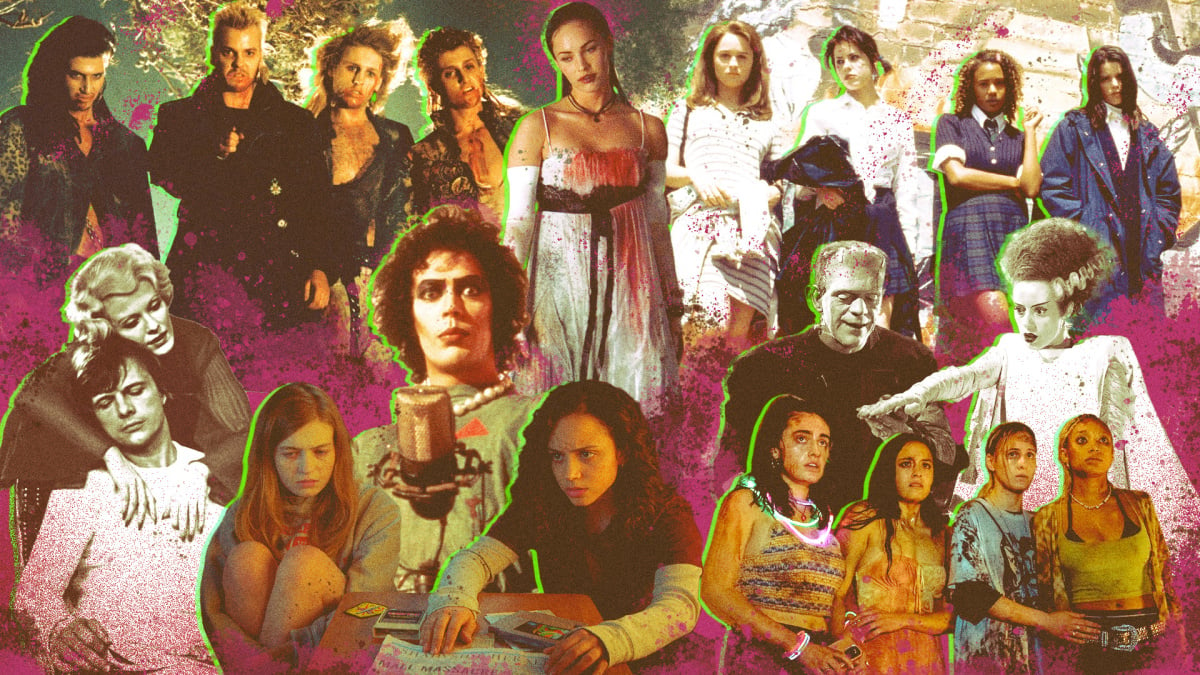Entertainment
The greatest queer horror films now streaming

There’s a reason the queer community loves horror. Sure, the spooks and campy thrills are fun, but as a genre, horror has long been a ripe territory for metaphor, and for exploring the dark and fantastical sides of otherness that’s so inherent to many queer and trans experiences.
Queerness has been all over the history of horror, even if it hasn’t always been loudly represented. From the queer coding of classic monster films to very obviously gay vampire flicks, from horror sci-fi explorations of gender identity to the openly LGBTQ+ characters of modern slashers, queer and trans audiences have long found themselves reflected — whether intentionally or not — in the horror genre.
This spooky season, whether you’re in the mood for a queer cannibal romance, a surreal lesbian vampire tale, a gay cruising thriller, a haunted house comedy, or a trans horror twist on The Little Mermaid, there are plenty of films to keep you entertained and up at night throughout October.
Jennifer’s Body

Credit: Filmstore/Shutterstock
“I go both ways.” Name a better, queerer, and funnier line of dialogue from a horror movie monster. Megan Fox’s iconic “My tit!” reaction is a close second. Both of those lines from Jennifer’s Body highlight the brilliance of Diablo Cody’s script, and the perfect balance of tone that director Karyn Kusama strikes throughout the cult horror comedy, a film unfairly lambasted upon release that’s found its long-deserved appreciation in recent years.
Back in 2009, Jennifer’s Body was slammed by male critics and audiences with a 46 percent Rotten Tomatoes score and a C- Cinemascore. But despite a misleading marketing campaign, this was never a film for men, and it especially wasn’t the usual type of horror film cisgender heterosexual men men were used to watching, where female characters are victimized for their viewing pleasure. This is a film about the absolute hell that is growing up as a teenage girl, about male violence towards and the sexualization of femininity, about trauma, and about the monstrous pain of queer repression. Jennifer’s Body cleverly uses the tools of its genre — over-the-top gore, suspense, and camp — to subvert expectations and tell a story that, at its tit-covered heart, is funny as hell, and pretty damn gay.
How to watch: Jennifer’s Body is streaming on Max, and available for rent or purchase on Prime Video and Apple TV.
Cat People (1942)
Lesbians, cats, and witchcraft collide oh-so-perfectly in the fantastic B-horror movie Cat People (not to be confused with Paul Schrader’s synth-heavy 1982 remake, which shifted its focus to even more risqué taboos, such as, uh, incest). This eerie, atmospheric film from Jacques Tourneur follows a Serbian woman named Irena (Simone Simon) who becomes fixated on the idea that she may be a descendant of an ancient society of people who morphed into cats. “Crazy!” thinks her new husband, who’s also aware of the fact that Irena has yet to kiss him, and who’s also spending more and more time with his pretty female coworker. Irena grows jealous of this other woman and begins to stalk her. The rest is greatest left discovered in this deliciously sinister masterpiece that uses expressionistic noir photography to build suspense and link the ostracization of lesbian desire with monstrosity.
How to watch: Cat People is streaming on Max and available for rent or purchase on Prime Video and Apple TV.
Stranger By the Lake

Credit: Les Film Du Worso/Arte France Cinema/Prods/Kobal/Shutterstock
Set at a gay cruising beach in the glistening summertime of rural France, 2013’s Stranger By the Lake remains one of the most fascinating, haunting, and sexiest erotic thrillers of years. Franck (Pierre Deladonchamps) arrives at the popular cruising spot and soon sets his eye on a mysterious stud named Michel (Christophe Paou). The attraction is mutual, as some incredibly hot beachside sex scenes show, but Stranger By the Lake makes a severe pivot when one character witnesses a horrific act. In Alain Guiraudie’s film, the horror comes less from what’s seen on screen and more from the film’s psychological examination of lust and voyeurism — particularly when intimacy and desire become tangled up with acts of violence and aggression.
How to watch: Stranger By the Lake is streaming for free on Kanopy and available for rent or purchase on Prime Video and VUDU.
Under the Skin

Credit: Filmnation/Jw/Kobal/Shutterstock
Jonathan Glazer’s sci-fi masterpiece Under the Skin is the type of movie that leaves you uncomfortable, transfixed, and possibly unable to move from your seat once the credits roll. Scarlett Johansson, giving what is easily her greatest and most subtle performance, plays a nameless woman who drives around Scotland at night searching for random men to pick up in her van. The rest is greatest left unspoiled, but what earns it a spot on this list is how Under the Skin serves as a fascinating exploration of what it feels like to be a trans person in a society dominated by, and oriented around, cisnormative ideas of gender and bodies. It’s a haunting tale about otherness, about the paralyzing loneliness and horror of realizing that you — and your body — are not like those around you, that it’s alien, even unnatural to some. Under the Skin, almost surely unintentionally on Glazer’s part, taps into a specific trans perspective of the interior longing to connect with, to understand, and to feel aligned with the exterior. It’s beautiful and tragic and horrifying, and some of the most imaginative sci-fi horror filmmaking the genre’s ever seen.
How to watch: Under the Skin is streaming on Max and available for rent or purchase on Prime Video and Apple TV.
Bones and All

Credit: Yannis Drakoulidis / Metro Goldwyn Mayer Pictures
In director Luca Guadagnino’s Bones and All, cannibalism serves as a potent metaphor for an unquenchable desire and longing for that which is taboo or even evil by some standards. It’s clear to see the queer symbolism across the horror romance starring Taylor Russell and Timothée Chalamet who play a pair of outcast lovers on the run, à la Terrence Malick’s Badlands — and there are some explicit queer moments throughout. The two wanderers both suffer from an inescapable hunger to feed on people, a new twist on the age-old horror trope of vampirism as a metaphor for queer desire. Remove the grotesque element of eating people, and you get a story about two teens burdened with shame and alienation simply for the way they yearn for love and connection. But Bones and All also understands how that non-heteronormative longing is viewed as grotesque and monstrous by so much of society. Fans of Guadagnino’s other work, like Call Me By Your Name, Suspiria, and I Am Love, will find plenty of thematic parallels here, only instead of Chalamet sensually devouring a peach, it’s a bloody corpse.
How to watch: Bones and All is streaming on Prime Video and available for rent or purchase on Apple TV.
Daughters of Darkness

Credit: Filmstore/Shutterstock
Vampire films have long been fixtures of sapphic storytelling, from 1936’s Dracula’s Daughter to the explosion of lesbian vamp films in the ’70s, but Daughters of Darkness is easily the GOAT. This 1971 Belgian film takes the folklore of Elizabeth Báthory — a 16th century Hungarian countess rumored to have drunk the blood of the women she lusted after — and turns it into an erotic psychological horror story.
French actress Delphine Seyrig plays the Countess, a platinum blonde, red-lipsticked menace who saunters around a vacant seaside hotel in sparkling gowns alongside her quiet secretary/girlfriend. But when a young woman arrives on honeymoon with her husband, the Countess’s unquenchable desire sets in, and she’ll do anything to have her. Daughters of Darkness is a surreal trip of a movie that’s like the stylish and subversive art-house cinema of Rainer Werner Fassbinder cross-pollinated with ’70s lesbian erotica.
How to watch: Daughters of Darkness is streaming on Shudder, AMC+ or Shudder via Prime Video, and with ads on VUDU, and is available for rent or purchase on Apple TV.
Bodies Bodies Bodies

Credit: Erik Chakeen
Bodies Bodies Bodies is the most Gen Z slasher comedy you could imagine — it’s Clue with rich, coked-out twentysomethings stuck in a mansion during a hurricane with nothing but TikTok, liquor, and drama to keep them occupied. When Sophie (Amandla Stenberg) brings her shy new girlfriend, Bee (Maria Bakalova), to her greatest friend David’s (Pete Davidson) lavish house to shelter in/party at during a storm, the vibes are immediately sour. Sophie’s friends bristle at her unexpected arrival, her awkward girlfriend, and how she ghosted them after she went to rehab. But it’s nothing some shots and pills can’t fix. When the group sits down to play the titular murder mystery game, that’s when everything goes haywire and an actual dead body winds up in the house. Director Halina Reijn’s film is a deliciously fun and gory mix of comedy, suspense, and drama — much of that comedy so perfectly nailed by standout Rachel Sennott — proving that the most deadly weapons aren’t candlesticks or lead pipes, but backstabbing bitchy gossip.
How to watch: Bodies Bodies Bodies is streaming on Paramount+ and Showtime, and is available to rent or purchase on Prime Video and Apple TV.
The Lure
The Lure has been described as a lesbian mermaid horror musical, but somehow even that doesn’t come close to capturing what this audacious Polish film is. Agnieszka Smoczyńska‘s debut feature is the darkest retelling of The Little Mermaid you could imagine, incorporating grisly violence and the sex work industry into that classic fairytale.
After two young singing mermaids, Silver (Marta Mazurek) and Gold (Michalina Olszańska), are invited onshore, the girls become the newest members of a cabaret-like band where they strip and dance on stage. The girls have legs when out of water but no genitals (much to the male characters’ frustration), which becomes a focal point for Silver, who becomes increasingly desperate for an operation to change that. The only catch is, losing her fin also means losing her voice.
This is where The Lure becomes a trans take on the classic mermaid story. It’s a metaphor for medical transition, a grim love story with incisive commentary on transmisogyny, and through the characters of Silver and Gold, the film explores two different trans feminine perspectives on transition, as well as their own queer sexuality. The Lure is a gory, thrilling, and bold spectacle that’s unlike anything you’ve ever seen.
How to watch: The Lure is streaming on The Criterion Channel and Max, and is available to rent or purchase on Alamo Drafthouse on Demand, Prime Video, and Apple TV.
Fear Street

Credit: Netflix
Leigh Janiak’s Fear Street trilogy is the queer horror thrill ride of every ’90s kid’s dreams. Spanning three time periods with two separate casts and a queer couple as the protagonists, the Fear Street films bring R.L. Stine’s book series to the screen with plenty of blood, spooky lore, teen romance drama, and some killer ’90s needle drops on the soundtrack. The story centers on a group of friends who try to undo a decades-old curse on their town that’s led to it being dubbed the murder capital of the country. Most fun and innovative is how each film in Janiak’s trilogy pays homage to a different horror subgenre, from Fear Street Part 1: 1994 evoking the slasher vibes of Scream and I Know What You Did Last Summer, the Friday the 13th terror of Fear Street Part 2: 1978, and the pagan folk horror of the witchy finale, Fear Street Part 3: 1666.
But these films aren’t just on this list for simply having queer leads. Janiak’s trilogy is keenly aware of the history of horror as an avenue to subtextually explore queer identity. Instead of playing into that legacy of coding, she uses the classic tropes of the genre to give us a narrative that is explicitly about queer repression, and in turn, unabashedly celebrates the power of queer love.
How to watch: The Fear Street trilogy is streaming on Netflix.
The Bride of Frankenstein

Credit: Universal/Kobal/Shutterstock
Many pre-code classic horror films are gurgling with queerness, and much of that is thanks to the work of openly gay filmmaker James Whale. Everything from Frankenstein to The Old Dark House and The Invisible Man has been dissected by queer film historians, but it’s Whale’s The Bride of Frankenstein that remains the queerest of them all. This is a movie about the ways gay male relationships are constantly thwarted by society and deemed, well, monstrous.
Sure, the sequel is about the creation of a female mate for Boris Karloff’s Monster, but that preoccupation with heterosexuality is kinda the point — she’s the beard. Of course, no one in this movie is overtly gay, but you can read the Monster finding safety with a blind man as him finding a gay companion, or even the Bride’s creation scene as two men’s attempt to use their power to create life despite their inability to procreate together. From the layers of queer coding and campy humor all over Whale’s sequel, it’s no doubt Elsa Lanchester’s Bride has become cemented as a fixture of drag culture.
How to watch: The Bride of Frankenstein is streaming on Peacock, and is available to rent or purchase on Prime Video, Apple TV, and VUDU.
The Blackening

Credit: Glen Wilson
“Name a horror movie where the Black character survives” is the first trivia question to kick off the twisted murder game at the center of The Blackening. Morgan (Yvonne Orji) and Shawn (Jay Pharoah) are stumped, and understandably so, given the genre’s exploitation and tokenizing of Black characters (although just in case you also find yourself in a similar game of life-or-death trivia, there are a handful of films where Black folks do indeed live).
A clever slasher comedy that uses the genre to comment on the history of Black stereotypes across horror and Hollywood overall finds a group of friends reuniting at a remote cabin in the woods on Juneteenth. The group gets forced into playing a racist board game while being hunted by a masked killer, all while relationship tensions and drama pull the friends apart. Dewayne Perkins, who co-wrote the film with Tracy Oliver, also stars as the group’s token gay guy, which adds another layer of playful and refreshing commentary on both the Bury Your Gays trope and on gay masculinity in Black culture.
How to watch: The Blackening will be available to stream on Starz beginning Oct. 4; in the meantime, it’s available to rent or purchase on Prime Video, Apple TV, and VUDU.
The Hunger

Credit: Mgm/Ua/Kobal/Shutterstock
Few things are hotter than the image of Catherine Deneuve and David Bowie as cool-as-hell ancient vampires sauntering around an underground nightclub as they cruise for their next meal. But Tony Scott’s cult favorite The Hunger is memorable for more than its good-looking and fashionable leads; it’s also one of the sharpest examples of the vampire story as a metaphor for queerness.
In the world of these vampires, love, desire, and companionship goes beyond gender, and while Deneuve and Bowie’s Miriam and John Blaylock have been lovers for centuries, Miriam begins to set her sights on a new companion once John becomes ill: Susan Sarandon’s doctor Sarah. Beyond the lesbian love story, Scott’s 1983 film can also be read as a commentary on the AIDS crisis through John’s sudden onset of an incurable illness that his doctors mindlessly dismiss. There’s also a pervading sense of grief and loneliness across the film that feels true to the experiences of many LGBTQ+ folks who survived the AIDS epidemic — a haunting sadness that Miriam, the most ancient of vampires, is condemned to throughout her immortality, as she’s forced to forever grieve the lovers she outlasts.
How to watch: The Hunger is available to rent or purchase on Prime Video, Apple TV, and VUDU.
The Hitcher

Credit: Silver Screen/Hbo/Tri Star/Kobal/Shutterstock
In The Hitcher, a young guy driving across the country to his dream destination of California stops in the middle of a rainy night in who-knows-where to pick up a hitchhiker. Jim Halsey (C. Thomas Howell) can hardly keep his eyes open, so hopefully this stranger will help him stay awake. The stranger who calls himself John Ryder, played by a terrifying and near emotionless Rutger Hauer, is the exact type of hitchhiker your mother warned you about picking up — a maniacal killer.
On the surface, The Hitcher could be read as a classic road horror movie about a deranged psychopath who taunts and terrorizes with no motive. But queer coding is all over this ’80s film — so much so that Hauer doesn’t exactly make John’s advances on Jim subtle — and the film could easily be viewed as a horror thriller about a gay man hell-bent on unleashing his rage on heteronormative society, and perhaps seeking a partner to go on that killing spree with him. It’s a hair-raising chiller with some shocking moments of violence and plenty of suspense.
How to watch: The Hitcher is streaming on DIRECTV and Cinemax via Prime Video or via Hulu.
Hereditary

Credit: Palmstar Media/Kobal/Shutterstock
Bet you never considered how Hereditary is a horror movie about transmasculinity. On the surface, Ari Aster’s gory nightmare is about a family discovering a long-kept secret tied to the women of their ancestry. But when it is read through a trans lens, it’s also a story about the agonizing experience of dysphoria as a transmasc person in a body deemed female by society, and the subsequent demonic attempt to change that. Without spoiling too much for those unacquainted, Hereditary is littered with small exchanges of dialogue — Charlie saying of her late grandmother, “She had wanted me to be a boy” — and imagery that several trans folks, myself included on first viewing, have spotted. In a fantastic piece examining the transition allegory of Hereditary, writer Sasha Geffen analyzes the way Aster’s film “understands just how deep gender goes” in society, and in a very heightened anti-trans political period, filled with moral panic around transmasculine identity. Seen through that lens, Aster’s film takes on a whole new meaning.
How to watch: Hereditary is streaming on Max and is available to rent or purchase on Prime Video, Apple TV, and VUDU.
Thelma

Credit: Filmstore/Shutterstock
In Thelma, Norwegian filmmaker Joachim Trier takes the queer subtext of Brian De Palma’s Carrie and brings it right to the surface. In this 2017 psychological horror thriller, the titular Thelma (Eili Harboe) is a shy and repressed young woman who leaves her sheltered, conservative Christian home for the first time to go off to college. There, she discovers queer desire when she meets and becomes infatuated with Anja (Kaya Wilkins), along with a sudden onset of violent seizures that cause a series of strange happenings. Thelma’s powers, like Carrie’s, emerge as an outward manifestation of a suppressed woman’s desire for agency and control. What makes Trier’s film so visceral is how he uses the trappings of horror and supernatural storytelling to tell a very queer coming-of-age tale as Thelma grapples with expressing her rage and identity all at once.
How to watch: Thelma is streaming for free on Kanopy and for free with ads on Tubi, and is available to rent or purchase on Prime Video, Apple TV, and VUDU.
Wendell & Wild

Credit: Netflix
Wendell & Wild, the latest stop-motion horror fantasy from Henry Selick (The Nightmare Before Christmas, Coraline), follows the titular pair of demonic brothers desperate to escape the clutches of the underworld and their overlord father. The duo, voiced by Keegan-Michael Key and Jordan Peele, come up with a scheme to dupe a young orphan into inviting them into the free world of the living. Kat is a green-haired 13-year-old girl who blasts punk music through the halls of her new, all-girls Catholic school.
As much as the demon brothers and their satanic home may seem like the main bad guys of this story, the real villain of Wendell & Wild is pretty surprising: It’s the prison industrial complex. The true evil in Kat’s town is led by the Klaxons, a private prison corporation that’s been buying up all the local businesses. Through a series of spooky resurrections, Kat and her new friend Raúl, a young trans boy voiced by trans actor Sam Zelaya, attempt to defeat the Klaxons and get her deceased parents back.
How to watch: Wendell & Wild is streaming on Netflix.
The Craft

Credit: Columbia/Kobal/Shutterstock
Subtextual queerness in films doesn’t only mean unspoken nods to sexuality, but it also reflects the inherent otherness of growing up as a queer person — this is especially true for the horror genre. In the case of The Craft, queerness comes through in the form of four teenage girls whose goth aesthetic, rejection of the status quo, and witchy doings can be seen as a stand-in for the abnormality and derogatory difference that’s long been associated with being queer. In The Craft, it’s the weirdos, the freaks, the outcasts who turn to the supernatural to wield some sense of control over the strait-laced hetero world that rejects them so readily. What’s gayer than a bunch of girls exploring their power over their own bodies with a little Light As a Feather, Stiff As a Board sleepover seance anyway?
How to watch: The Craft is streaming on Hulu and available for rent or purchase on Prime Video, Apple TV, and VUDU.
Seconds

Credit: Paramount/Kobal/Shutterstock
In John Frankenheimer’s masterful sci-fi film Seconds, a middle-aged man who lives an unfulfilled life as a banker discovers a company that gives people alternate identities via plastic surgery. Arthur Hamilton (played by John Randolph) decides to undergo the procedure that turns him into the man of everyone’s dreams circa 1966: Rock Hudson. Arthur is now Tony Wilson (played by Hudson), a hot young artist with a beachside villa. But the transition into a new life, and keeping the secret of his old one, begins to torture Tony.
Seconds is a fascinating psychological horror sci-fi hybrid that speaks to trans and queer identity on multiple levels. An entire essay could be written about the trans themes of its narrative, from the emotional and psychological process of medical and social transition to the societal pressures to assimilate into a cis and hetero-centric life. Separately, Seconds also plays like an explicit commentary on Hudson’s own closeted life. Hudson’s performance as Tony, easily the most unnerving of his career, feels like a looking glass into what many assume was his own experience as a major star forced to keep a secret and live a double life in early Hollywood.
How to watch: Seconds is streaming for free on Kanopy and for free with ads on Pluto TV, and is available to rent or purchase on Prime Video and Apple TV.
Scream

Credit: Miramax/Kobal/Shutterstock
All gays know Scream is queer. It’s canon (no, literally). The iconic slasher franchise has queerness all over it — and the writers finally gave us an overt queer character in the latest installments, with Jasmin Savoy Brown‘s Mindy. But it’s the reveal of the killers behind the Ghostface mask at the end of the first Scream that really solidified things. Skeet Ulrich’s Billy and Matthew Lillard’s Stu were so obviously gay, so much so that even the first Scary Movie said it right out loud. Even Scream writer Kevin Williamson has revealed in recent years that the two characters were based on famed gay killers Leopold and Loeb. None of that confirmation was necessary though — the camp of Drew Barrymore making Jiffy Pop and fondling a knife in her cream knit sweater while gabbing on the phone with a murder? Gay as hell.
How to watch: Scream is streaming on Paramount+ and AMC+ via Prime Video, and is available to rent or purchase on Prime Video, Apple TV, and VUDU.
Interview with the Vampire
Ah yes, the film that gave us Tom Cruise and Brad Pitt as a gay vampire couple. While the curse of being a blood-sucking creature of the night has long been associated with queer identity, it has more often favored lesbian storytelling; however, Interview with the Vampire finally gave us two queer men bonded in their blood lust. Of course, the 1994 Neil Jordan film never made that gay relationship explicit, but there’s no doubt that when Cruise’s ancient vampire Lestat turns the young Louis (Pitt) into one of his kind, the two begin a life reminiscent of any closeted gay couple. They even turn and raise a young girl (Kirsten Dunst) as a child of their own. After venturing abroad, the little vampire family is threatened by the allure of another very hot, very gay vampire in Antonio Banderas’s Armand. While the recent AMC series made Louis and Lestat’s romance incredibly explicit (and incredibly sexual), we’ll always have the hush-hush gay desire of two of the ’90s biggest leading men sucking each other’s necks.
How to watch: Interview with the Vampire is streaming on Paramount+, and is available for rent or purchase on Prime Video, Apple TV, and VUDU.
We’re All Going to the World’s Fair
We’re All Going to the World’s Fair is a horror film for and about anyone who grew up with the internet. This micro-budget indie from filmmaker Jane Schoenbrun is essentially Creepypasta the Movie. Casey (Anna Cobb) is a lonely teen who joins an online role playing game and begins to grow paranoid that something strange is happening to her mind and body. Schoenbrun’s film isn’t scary in the traditional sense, except for some freaky creepypasta-esque imagery, but more so a film that aims to show the psychology of extreme loneliness, depression, and alienation — all intense, scary things that many queer folks who grew up online experienced.
While the film isn’t explicitly queer, it’s been hailed as a trans horror film by several critics, and it’s not hard to see why. Schoenbrun, who is nonbinary, has made a film that evokes the constant unease, terror, and anxiety of gender dysphoria before you may even know what that is, and the urge to escape into another reality (i.e., the internet) to find yourself. In one scene, Casey buoyantly dances in her room to a pop song before suddenly stopping, as if to realize she’s been possessed. She lets out a horrifying shriek, then goes right back to giddily dancing. It’s haunting in an indescribable way, and speaks to a constant masking and toggling between identities that’s all too familiar to the experience of dysphoria.
How to watch: We’re All Going to the World’s Fair is streaming on Max and Kanopy, and is available for rent or purchase on Prime Video and Apple TV.
The Rocky Horror Picture Show

Credit: Filmstore/Shutterstock
Rocky Horror might not be a movie that’ll give you nightmares — unless you’re afraid of kinky, horny queers going bananas at a deranged house party, and if so, get outta here! Nevertheless, the wacky cult classic is a spooky season staple. A riff on B-movie sci-fi and monster films of the past, the musical horror comedy takes us, along with Susan Sarandon and Barry Bostwick’s square-as-can-be couple, on a wild trip to Transsexual Transylvania. There’s Time-Warping and Tim Curry’s Frankenstein-esque monster-making, there’s ax-hunting and laser guns and seduction and dancing — so much dancing! Rocky Horror is a joyously bizarro classic that belongs to the weirdo queers and us alone.
How to watch: The Rocky Horror Picture Show is available for rent or purchase on Prime Video, Apple TV, and VUDU.
The Haunting

Credit: Mgm/Kobal/Shutterstock
The Haunting is a classic horror film about a classic type of horror story: a haunted house. You won’t find any cheap jump scares or acts of violence in this 1963 film, though. Instead, director Robert Wise and cinematographer Davis Boulton use a mix of innovative visual techniques and camera tricks, from gliding tracking shots and anamorphic lenses, to create an atmosphere of total paranoia and unease that’s genuinely unnerving to watch.
The film, based on the Shirley Jackson novel The Haunting of Hill House, follows a group of strangers who arrived at a haunted mansion to prove the existence of ghosts, including the timid Eleanor (Julie Harris) and the bold Theo (Claire Bloom) — yes, the same queer Theo from Netflix’s Hill House series. Theo is the rare example of an explicitly lesbian character in classic horror, much less classic cinema overall, and most notably, her queerness is never treated with disdain or mockery. While her sexuality isn’t overtly stated, it’s a fascinating element of a story about women choosing to experience the evils of a haunted house to escape the real-world anxieties and trauma of their daily lives.
How to watch: The Haunting is available for rent or purchase on Prime Video, Apple TV, and VUDU.
Border
An underseen gem, 2018’s Border is a Swedish body-horror romance about otherness that will speak to anyone who knows what it feels like to finally find someone like you. Tina (Eva Melander) is a customs officer with an ability to smell guilt, making her especially good at catching contraband at her job. Tina also believes she has some type of developmental disorder, describing herself as an “ugly, strange human with a chromosome flaw,” which leads to an isolated and lonely life. But one day a man with similar bodily features to Tina’s appears at her work, and it’s a powerful moment of recognizing that maybe she isn’t alone, and maybe she’s finally found her person.
Border is a wild, highly original tale full of unsettling twists that’s also super trans. Amid its dark fantasy and suspense, this Cannes Film Festival winner is a transfixing and emotional story about spending a lifetime thinking something is wrong with you, the rage and pain that can fester from it, and to finally feel seen as you are for the first time.
How to watch: Border is streaming on DIRECTV, Cinemax via Prime Video, and is available to rent or purchase on Apple TV and VUDU.
The Lost Boys

Credit: Warner Bros/Kobal/Shutterstock
In The Lost Boys, we get vampires in the form of a biker gang, and honestly, there’s nothing gayer than that. When brothers Michael (Jason Patric) and Sam (Corey Haim) move to a beachside town in Northern California with their mother (Dianne Wiest, who, by law, makes every film campier, gayer, and better), eldest brother Michael soon falls in with a local motorcycle crew who also happen to be blood-suckers. While it’s a girl who first catches Michael’s eye, there’s no denying the big queer energy that soon evolves when he’s initiated into the vampire group. Kiefer Sutherland as David Powers, the platinum blonde leather-clad leader of the gang, oozes homoerotic desire towards Michael, whose vampiric transformation can be read as a coming-out of sorts. Even Haim’s Sam can be read as queer through small but unmissable character details, like a very suggestive Rob Lowe poster hanging on his bedroom wall. The Joel Schumacher film brings campy, queer goodness to a genre storytelling staple that was foundational for many young queers.
How to watch: The Lost Boys is streaming on Fubo TV and Pluto TV, and is available for rent or purchase on Prime Video, Apple TV, and VUDU.
The Picture of Dorian Gray

Credit: Mgm/Kobal/Shutterstock
The Picture of Dorian Gray is a big, gay, gothic horror story about two rich older queens obsessed with the radiant beauty of a young closeted dandy, and how that young dandy sells his soul to stay forever gorgeous and young. Sure, the Oscar Wilde novel that Albert Lewin’s 1945 film is based on is about vanity and the superficial desires of a group of aristocratic white men, but it’s also about living with the unbearable torture of queer repression and internalized homophobia.
When the 22-year-old Dorian Gray (Hurd Hatfield) gazes upon his luminous portrait and wishes to never age a day, something magical happens — Dorian’s dashing looks remain fixed, and the portrait ages instead. It also begins to reflect the sins of Dorian’s behavior. It’s impossible to not read Dorian Gray through a queer lens, given Wilde’s personal life, as well as the flamboyant performances and attitudes expressed by the film’s three male characters. This is a story about doing absolutely everything in your power to suppress your true self to the outside world, and that no matter how hard you try, you’ll be forced to look at the wretched toll it takes on your soul.
How to watch: The Picture of Dorian Gray is available for rent or purchase on Prime Video, Apple TV, and VUDU.
The Shape of Water

Credit: K Hayes/20th Century Fox/Kobal/Shutterstock
No one blends fantasy and romance with horror and suspense quite like Guillermo del Toro. The 2018 Greatest Picture winner is a movie where the most otherized characters — a woman who uses ASL to communicate (Sally Hawkins’s Elisa), a closeted gay man (Richard Jenkins’s Giles), a Black woman (Octavia Spencer’s Zelda), and a giant fish-man (Doug Jones) — are targeted and labeled as the monsters threatening society. Del Toro takes the classic monster movie horror theatrics of The Creature from the Black Lagoon and reshapes it into a moving, heroic tale about those on the fringes of society fighting back and liberating themselves from the real monsters — in this case, Michael Shannon’s terrifying colonel set on hunting down Jones’s creature to exploit for the 1960s space race.
But The Shape of Water is also a love story that queers traditional hetero narratives through a swooning romance between Elisa and the fish-man. In del Toro’s fantastical world, two lonely and ostracized characters finally get to experience love, acceptance, and pleasure together — and that pleasure is incredibly sexual, as the filmmaker intended. With stunning visuals, an incredible blend of practical and CGI effects, some grisly gore, and lush romance, The Shape of Water pretty much has it all.
How to watch: The Shape of Water is streaming on Fubo TV, FX Now, DIRECTV, and with ads on Freevee and is available for rent or purchase on Prime Video, Apple TV, and VUDU.
Rebecca

Credit: Selznick/United Artists/Kobal/Shutterstock
Many classic Hitchcock films are brimming with queer undercurrents, from the transfeminine villany of Psycho to the gay murderous couple of Rope, but Rebecca offers a different kind of queer story. In the 1940 psychological thriller, Joan Fontaine’s second Mrs. de Winter and her new husband, Maxim (Laurence Olivier), arrive at the gothic mansion that is to be her new home, only to discover that that home is deeply haunted by echoes of the first Mrs. de Winter. It’s Maxim’s late wife, the never-seen Rebecca, who consumes our otherwise-unnamed protagonist with jealousy and self-doubt.
Where the queerness arrives most notably is in the form of the icy housekeeper, Mrs. Danvers (Judith Anderson), who reveals her not-so-subtle obsession with the late Rebecca. In one famously analyzed scene, Mrs. Danvers gives a tour of Rebecca’s old bedroom, caressing her dressing gown, displaying her underwear drawer as if it were treasure, and speaking of Rebecca as if she were a longtime secret lover. This suggestion of a lesbian affair between the women isn’t merely speculation, either. Rebecca author Daphne du Maurier was said to have been bi, and even during the 1940 film’s production, the Hays Code sent threatening letters to producer David O. Selznick to remove the queer subtext. Yet, gay Rebecca persisted.
How to watch: Rebecca is streaming on Roku and CINÉMOI via YouTube.
-

 Entertainment7 days ago
Entertainment7 days ago2024 summer TV preview: 33 TV shows to watch this summer
-

 Business6 days ago
Business6 days agoGoogle Gemini: Everything you need to know about the new generative AI platform
-

 Business4 days ago
Business4 days agoHaun Ventures is riding the bitcoin high
-

 Entertainment6 days ago
Entertainment6 days ago‘Bridgerton’: Everything you need to remember before Season 3
-

 Entertainment4 days ago
Entertainment4 days agoHands-on with the Claude AI app: It’s pleasant to use, but janky
-

 Entertainment4 days ago
Entertainment4 days ago5 essential gadgets for turning your home into a self-care sanctuary
-

 Entertainment5 days ago
Entertainment5 days agoHow to unblock porn sites: Greatest VPN for porn in 2024
-

 Business6 days ago
Business6 days agoIndian ride-hailing giant Ola cuts 180 jobs in profitability push




























